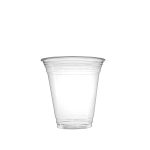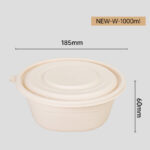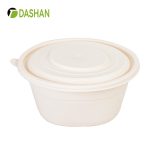Quick Summary
PFOA free means products are made without perfluorooctanoic acid, a harmful chemical linked to health and environmental risks. Choosing PFOA free cookware, packaging, and tableware ensures safer, more sustainable options for everyday use.
1. Introduction to PFOA
Perfluorooctanoic acid (PFOA) is a synthetic chemical belonging to the broader family of per- and polyfluoroalkyl substances (PFAS), often referred to as “forever chemicals” due to their persistence in the environment and human body. For decades, PFOA played an important role in industrial and consumer applications. It was a critical ingredient in manufacturing non-stick cookware coatings, stain-resistant fabrics, waterproof clothing, carpets, and even some firefighting foams.
However, the very properties that made PFOA so useful—its resistance to heat, water, and oil—also make it dangerous. Because it does not naturally break down, PFOA accumulates in the environment and human body, creating long-term health and ecological risks.
Today, consumers and industries alike are increasingly turning to PFOA-free alternatives as awareness of these risks grows.
2. Understanding PFOA’s Applications
Historically, PFOA was prized for its unique resistance properties. It enabled manufacturers to produce:
-
Non-stick cookware that prevented food from sticking and made cleaning easier.
-
Stain-resistant carpets and fabrics, especially for homes and offices.
-
Water-repellent clothing for outdoor and sportswear.
-
Firefighting foams used in airports and industrial facilities.
These applications contributed significantly to consumer convenience and industrial efficiency. Yet, they also left a lasting mark on public health and the environment.
3. Health Implications of PFOA Exposure
Over the past 30 years, researchers have uncovered troubling connections between PFOA exposure and human health.
-
Epidemiological evidence links PFOA to:
-
Immune system disruption
-
Thyroid and liver disease
-
Kidney disease
-
Lipid and insulin dysregulation
-
Reproductive and developmental problems
-
Increased cancer risk
-
-
Animal studies reinforce these findings, showing PFOA can cause tumors in the liver, testicles, mammary glands, and pancreas.
Although results from animal studies do not always translate directly to humans, they raise significant concerns. Combined with human data, they provide a compelling case for eliminating PFOA wherever possible.
4. Environmental Persistence and Impact
One of the most concerning aspects of PFOA is its persistence. Unlike organic compounds that break down naturally, PFOA remains stable for decades, if not centuries.
-
It contaminates water sources, soil, and wildlife.
-
It accumulates in human bloodstreams, with traces detected in populations worldwide.
-
Communities near chemical plants face especially high risks. For example, a federal lawsuit revealed that a facility in West Virginia released large amounts of PFAS, including PFOA, into the Ohio River, creating environmental and health crises for surrounding residents.
This “forever chemical” characteristic underscores the urgency of moving towards PFOA-free solutions.
5. The Shift Towards PFOA-Free Products
As scientific evidence mounted, governments, advocacy groups, and consumers began pressuring manufacturers to eliminate PFOA from their products. The term “PFOA-free” now signals that a product has been manufactured without perfluorooctanoic acid.
This shift is visible across industries:
-
Cookware: Many brands now offer PFOA-free non-stick pans using alternative coatings like ceramic or titanium.
-
Textiles: Clothing companies are reformulating fabrics to avoid PFAS altogether.
-
Food packaging: Brands are moving towards biodegradable options such as sugarcane bagasse containers, PLA bioplastics, and cornstarch tableware, which are both PFOA-free and eco-friendly.
For consumers, “PFOA-free” has become a trusted label representing safety, sustainability, and responsible production.
6. Regulatory Actions and Industry Response
Global Regulatory Actions
-
European Union (EU): Restricted the use of PFOA under the REACH regulation, significantly limiting its applications.
-
United States (EPA): Established health advisories for PFOA in drinking water and is working on enforceable nationwide standards.
-
Other regions: Countries in Asia and South America are following suit, increasingly banning or limiting PFAS in consumer goods.
Industry Response
-
Cookware manufacturers reformulated products to eliminate PFOA, replacing it with safer coatings.
-
Foodservice packaging companies shifted to plant-based solutions like bagasse and PLA.
-
Retailers are demanding that suppliers certify PFOA-free production processes.
Together, these efforts are reshaping global supply chains.
7. Market Trends and Consumer Preferences
Consumer awareness has fueled demand for transparency in labeling. Surveys indicate:
-
Shoppers actively seek out “PFOA-free”, “PFAS-free”, and “BPA-free” labels.
-
Eco-conscious consumers are more likely to purchase from brands that emphasize chemical-free and compostable alternatives.
-
Restaurants, QSRs (Quick Service Restaurants), and retailers are switching to PFOA-free packaging to comply with regulations and meet sustainability goals.
This consumer-driven movement accelerates the shift to safer alternatives.
8. Challenges and Considerations
While the move to PFOA-free products is widely positive, it is not without challenges.
-
Replacement chemicals: Some substitutes are not thoroughly tested. Regulators must ensure replacements do not introduce new risks.
-
Performance issues: Certain PFOA-free cookware may not last as long or perform as effectively as traditional non-stick options.
-
Cost barriers: Alternative materials like bagasse and PLA may cost more, though economies of scale are gradually reducing prices.
To maintain progress, continuous research, innovation, and policy enforcement are needed.
9. Cornstarch Tableware & Safer Packaging Options
One of the most promising PFOA-free alternatives lies in plant-based packaging:
-
Cornstarch Tableware: Renewable, biodegradable, and compostable, providing a natural replacement for plastic plates, spoons, and cutlery.
-
Sugarcane Bagasse Packaging: Strong, heat-resistant, and compostable—ideal for restaurants, QSRs, and supermarkets.
-
PLA Bioplastics: Transparent, lightweight, and suitable for cold drinks and salads.
These solutions offer zero PFOA, zero PFAS, and align with global efforts to eliminate harmful chemicals from food contact materials.
10. Conclusion
The designation “PFOA-free” represents more than just a label—it marks a cultural and industrial shift towards safer products and a healthier environment.
-
Health perspective: PFOA exposure is linked to cancer, liver disease, hormone disruption, and reproductive risks.
-
Environmental perspective: Its persistence contaminates soil, water, and ecosystems for generations.
-
Market perspective: Regulatory bans, corporate responsibility, and consumer preferences are driving adoption of alternatives.
Cornstarch tableware, sugarcane bagasse containers, and PLA packaging represent the future of safe, sustainable, and PFOA-free solutions. By making informed choices, consumers and businesses can protect health, support innovation, and accelerate the transition to a cleaner, chemical-free future.
FAQ
1. What does PFOA-free mean?
PFOA-free means the product does not contain perfluorooctanoic acid, a synthetic chemical previously used in nonstick coatings and food packaging now linked to health risks.
2. Why is PFOA considered harmful?
PFOA has been associated with potential health effects such as hormone disruption, liver damage, and increased cancer risk. It is also persistent in the environment and the human body.
3. Are PFOA and PFAS the same thing?
Not exactly. PFOA is one type of PFAS. PFAS is a broader class of chemicals, often called “forever chemicals,” which includes PFOA and many others with similar properties.
4. Is PFOA still used in cookware and food packaging?
Most manufacturers have phased out PFOA due to health concerns. However, some imported products may still contain it, so checking for “PFOA-free” labeling is recommended.
5. What are the alternatives to PFOA in dinnerware and packaging?
Safer alternatives include ceramic, stainless steel, sugarcane bagasse, PLA bioplastics, and cornstarch tableware.
6. How do I know if a product is truly PFOA-free?
Check for third-party certifications or manufacturer disclosures. Reputable brands often highlight PFOA-free and non-toxic materials in product descriptions or packaging.
7. Are PFOA-free products safe for daily use?
Yes, PFOA-free products are considered safer for everyday use, especially in cookware and food packaging, helping to minimize toxic exposure and protect long-term health.
References
- “Epidemiologic Evidence on the Health Effects of Perfluorooctanoic Acid (PFOA)”
Kyle Steenland
https://pmc.ncbi.nlm.nih.gov/articles/PMC2920088/ - “How PFAS Impacts Your Health”
Agency for Toxic Substances and Disease Registry (ATSDR)
https://www.atsdr.cdc.gov/pfas/about/health-effects.html - “Our Current Understanding of the Human Health and Environmental Risks of PFAS”
United States Environmental Protection Agency (EPA)
https://www.epa.gov/pfas/our-current-understanding-human-health-and-environmental-risks-pfas - “PFOA, PFOS, and Related PFAS Chemicals”
American Cancer Society
https://www.cancer.org/cancer/risk-prevention/chemicals/teflon-and-perfluorooctanoic-acid-pfoa.html - “Per- and Polyfluoroalkyl Substance Toxicity and Human Health Review”
Bevin E. Blake and Suzanne E. Fenton
https://pmc.ncbi.nlm.nih.gov/articles/PMC7906952/ - “Environmental Impacts, Exposure Pathways, and Health Effects of PFAS”
PubMed
https://pubmed.ncbi.nlm.nih.gov/37976959/ - “Past PFOA and PFOS Health Effects Science Documents”
United States Environmental Protection Agency (EPA)
https://www.epa.gov/sdwa/past-pfoa-and-pfos-health-effects-science-documents - “Perfluorooctanoic Acid (PFOA) and Water”
Minnesota Department of Health
https://www.health.state.mn.us/communities/environment/risk/docs/guidance/gw/pfoainfo.pdf - “PFAS Exposure and Risk of Cancer”
National Cancer Institute (NCI)
https://dceg.cancer.gov/research/what-we-study/pfas - “Per- and Polyfluoroalkyl Substances”
Wikipedia Contributors
https://en.wikipedia.org/wiki/Per-_and_polyfluoroalkyl_substances





